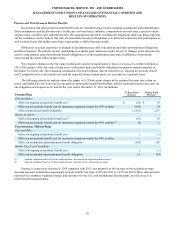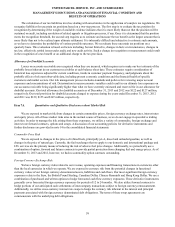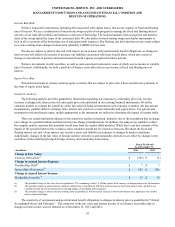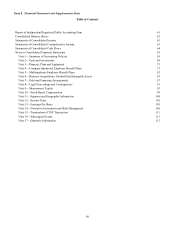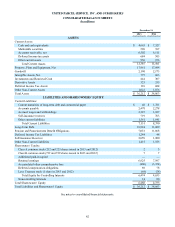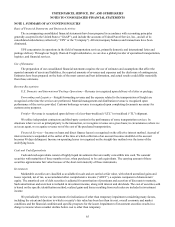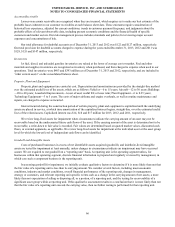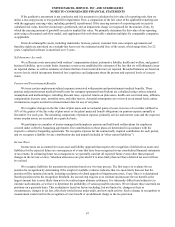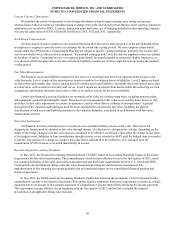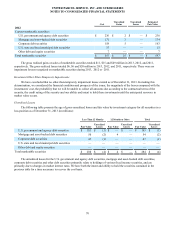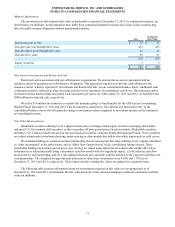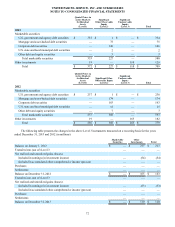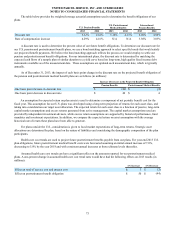UPS 2013 Annual Report Download - page 78
Download and view the complete annual report
Please find page 78 of the 2013 UPS annual report below. You can navigate through the pages in the report by either clicking on the pages listed below, or by using the keyword search tool below to find specific information within the annual report.UNITED PARCEL SERVICE, INC. AND SUBSIDIARIES
NOTES TO CONSOLIDATED FINANCIAL STATEMENTS
66
Accounts Receivable
Losses on accounts receivable are recognized when they are incurred, which requires us to make our best estimate of the
probable losses inherent in our customer receivables at each balance sheet date. These estimates require consideration of
historical loss experience, adjusted for current conditions, trends in customer payment frequency, and judgments about the
probable effects of relevant observable data, including present economic conditions and the financial health of specific
customers and market sectors. Our risk management process includes standards and policies for reviewing major account
exposures and concentrations of risk.
Our total allowance for doubtful accounts as of December 31, 2013 and 2012 was $122 and $127 million, respectively.
Our total provision for doubtful accounts charged to expense during the years ended December 31, 2013, 2012 and 2011 was
$129, $155 and $147 million, respectively.
Inventories
Jet fuel, diesel, and unleaded gasoline inventories are valued at the lower of average cost or market. Fuel and other
materials and supplies inventories are recognized as inventory when purchased, and then charged to expense when used in our
operations. Total inventories were $403 and $393 million as of December 31, 2013 and 2012, respectively, and are included in
“other current assets” on the consolidated balance sheet.
Property, Plant and Equipment
Property, plant and equipment are carried at cost. Depreciation and amortization are provided by the straight-line method
over the estimated useful lives of the assets, which are as follows: Vehicles—6 to 15 years; Aircraft—12 to 30 years; Buildings
—20 to 40 years; Leasehold Improvements—lesser of asset useful life or lease term; Plant Equipment—6 to 8.25 years;
Technology Equipment—3 to 5 years. The costs of major airframe and engine overhauls, as well as routine maintenance and
repairs, are charged to expense as incurred.
Interest incurred during the construction period of certain property, plant and equipment is capitalized until the underlying
assets are placed in service, at which time amortization of the capitalized interest begins, straight-line, over the estimated useful
lives of the related assets. Capitalized interest was $14, $18 and $17 million for 2013, 2012, and 2011, respectively.
We review long-lived assets for impairment when circumstances indicate the carrying amount of an asset may not be
recoverable based on the undiscounted future cash flows of the asset. If the carrying amount of the asset is determined not to be
recoverable, a write-down to fair value is recorded. Fair values are determined based on quoted market values, discounted cash
flows, or external appraisals, as applicable. We review long-lived assets for impairment at the individual asset or the asset group
level for which the lowest level of independent cash flows can be identified.
Goodwill and Intangible Assets
Costs of purchased businesses in excess of net identifiable assets acquired (goodwill), and indefinite-lived intangible
assets are tested for impairment at least annually, unless changes in circumstances indicate an impairment may have occurred
sooner. We are required to test goodwill on a “reporting unit” basis. A reporting unit is the operating segment unless, for
businesses within that operating segment, discrete financial information is prepared and regularly reviewed by management, in
which case such a component business is the reporting unit.
In assessing goodwill for impairment, we initially evaluate qualitative factors to determine if it is more likely than not that
the fair value of a reporting unit is less than its carrying amount. We consider several factors, including macroeconomic
conditions, industry and market conditions, overall financial performance of the reporting unit, changes in management,
strategy or customers, and relevant reporting unit specific events such as a change in the carrying amount of net assets, a more
likely than not expectation of selling or disposing all, or a portion, of a reporting unit, and the testing for recoverability of a
significant asset group within a reporting unit. If this qualitative assessment results in a conclusion that it is more likely than not
that the fair value of a reporting unit exceeds the carrying value, then no further testing is performed for that reporting unit.


